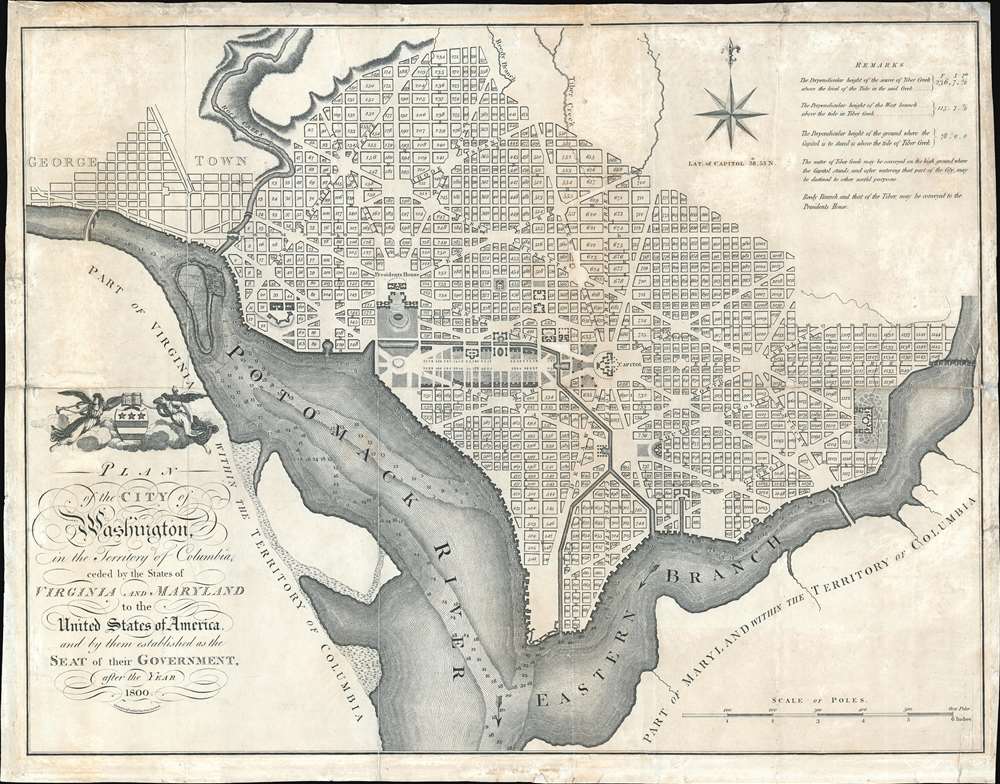This item has been sold, but you can get on the Waitlist to be notified if another example becomes available, or purchase a digital scan.
1795 Russell / Ellicott Map of Washington D. C.
WashingtonDC-ellicottrussell-1795
Title
1795 (undated) 15.75 x 20.75 in (40.005 x 52.705 cm) 1 : 19800
Description
Forming the District of Columbia
The District of Columbia was created by the Residence Act of 1790, in which a 10-mile square parcel of land was partitioned off from Virginia and Maryland to establish a new city as the seat of the U.S. Federal Government. When this map was drawn, the national capital was still in the planning stages and most of what can been seen here was not yet developed. In 1792 when Ellicott drafted the plan, the confluence of the Potomac and the Anacostia was little more than a fetid swamp.A Grand, 'European' Capital
George Washington engaged the French engineer, artist, and urban designer Pierre Charles L'Enfant 1754 - 1825) to design the new capital. It was L'Enfant who laid out Washington D.C.'s iconic ray and grid street pattern. Ellicott, a well-respected American surveyor, was, in the meantime, hired on the recommendation of Thomas Jefferson to survey the boundary of the District of Columbia. While completing his project, Ellicott worked closely with L'Enfant, creating a vision of a grand capital on the European model, with large boulevards, public plazas, and dramatic vistas.L'Enfant and George Washington had a falling out in February of 1792 over the printing of L'Enfant's plan. L'Enfant was fired and, in a fit of anger, refused to turn over his completed plans. Washington turned to Ellicott, who having worked closely with L'Enfant, was able to produce a close variant of the L'Enfant design, this map, which was ultimately used to construct the national capital city. It is of note that L'Enfant's name appears nowhere on this map and Ellicott takes all credit for the design, a clear slap in the face to the brilliant and temperamental Frenchman.
Publication History and Census
The present example, engraved in 1795 by John Russell based on the Thackara and Vallance edition of 1792, was intended for inclusion in H. D. Symonds' An American Atlas, but examples also appear in Winterbotham's A Historical, Geographical, Commercial and Philosophical View ... printed in London that same year. Perhaps a dozen examples appear catalogued separately in OCLC.CartographerS
Andrew Ellicott (January 24, 1754 – August 28, 1820) was an American cartographer, surveyor, and statesman active in the late 18th and early 29th centuries. He is best known for his work surveying the boundaries of Washington D.C. and completing Pierre Charles L'Enfant's plan for said city. Ellicott was born to a Pennsylvania Quaker family in Buckingham, Bucks County. He was educated at the local Quaker School where he exhibited an early aptitude for mechanics and mathematics. In 1770 his father, Joseph Ellicott (1732–1780), and uncles Andrew Ellicott (1733 – 1809) and John Ellicott (December 28, 1739 – December 28, 1794), purchased land on the Patapsco River with where they relocated and established a milling business, naming the town Ellicott Mills, today's Ellicott City, Maryland. With the outbreak of the American Revolutionary War, Ellicott joined the Maryland Elk Ridge Battalion as a commissioned Lieutenant. During the course of the war he reached the rank of Major, which he maintained as an honorific even after the war. From 1791 to 1792, at the request of then Secretary of State Thomas Jefferson, Ellicott began to survey the boundaries of the newly established District of Columbia. During this same period, he also surveyed, with French urban planner Pierre Charles L'Enfant (August 2, 1754 – June 14, 1825), the future city of Washington, which then occupied only a small potation of territory reserved for the District of Columbia. In February of 1792 the Commissioners had a falling out with L'Enfant after which L'Enfant refused to submit a copy of his plan for Washington D.C. Ellicott, being familiar with Ellicott's methods and style, completed the plan, creating thus the plan upon the nation's capital was subsequently built. In additional to his work in Washington D.C., Ellicott laid out the plan for the city if Erie, Pennsylvania and from 1796, worked on the Spanish-American border in the Gulf Coast, establishing Ellicott's Line, the modern-day border between Alabama and Florida. In 1803 he mentored Meriwether Lewis, one of the leaders of the Lewis and Clark Expedition, on field survey techniques. From 1813 he taught mathematics at the Military Academy at West Point. The final significant survey he completed was the resurvey of the Collins-Valentine Line between Quebec, New York, and Vermont. Three years later he died from a stroke at West Point. More by this mapmaker...
John Russell (c. 1750 - 1829) was a British cartographer active in London during the late 18th and early 19th centuries. Russell apprenticed as a goldsmith under William Palmer before turning to engraving and printing. He drew maps and engraved for several major publishers of his period including Alexander Dalrymple, Benjamin Henry, Robert Sayer, John Moore, and William Guthrie. Russell's 10 apprentices included such prominent cartographers as Alexander Findlay and Samuel Clapp. Russell was based on Constitution Row Grays Inn Lane, Middlesex (London). Learn More...

